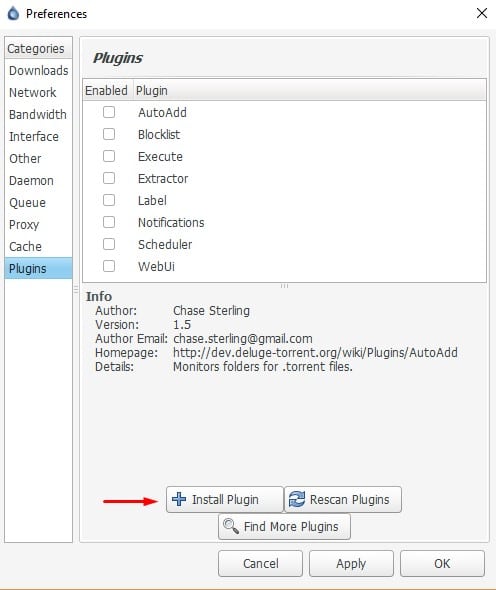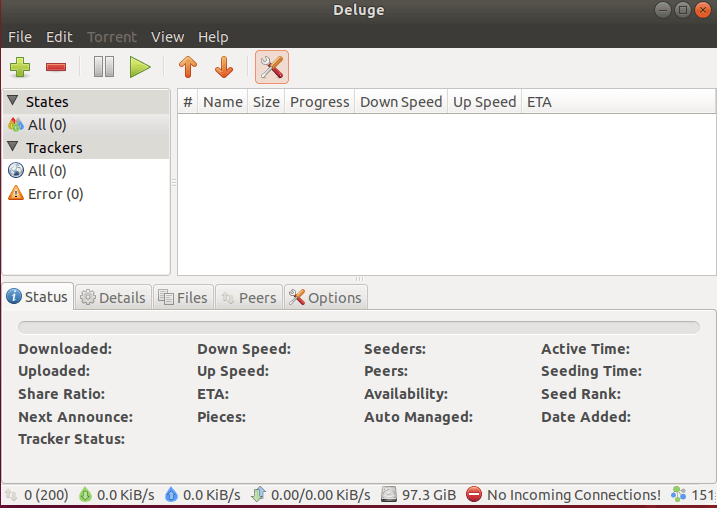

- SETUP DELUGE TORRENT HOW TO
- SETUP DELUGE TORRENT INSTALL
- SETUP DELUGE TORRENT SOFTWARE
- SETUP DELUGE TORRENT PASSWORD
We can notice that both scripts include lines that will make the client and the WebUI run under the user and group we created earlier on in the tutorial.įinally we need to reboot and then test the scripts using the following commands: sudo rebootsudo service deluge stopsudo service deluge start

Once this is run, paste the following into nano and then save the file by pressing Control + X and then pressing Y to accept the changes: # Deluge WebUI# Provides a WebUI on# on started delugestop on stopping delugeenv uid=delugeenv gid=delugeenv umask=027exec start-stop-daemon -S -c $uid:$gid -k $umask -x /usr/bin/deluge-web

To do this, run the following command in the terminal: sudo nano /etc/init/nf Now we need to write the init script for the WebUI. Once this is run, paste the following into nano and then save the file by pressing Control + X and then pressing Y to accept the changes: # Deluge Client Daemon# Starts On System Bootstart on (filesystem and networking) or runlevel stop on runlevel env uid=delugeenv gid=delugeenv umask=022exec start-stop-daemon -S -c $uid:$gid -k $umask -x /usr/bin/deluged. To do this, we need to run the following command in the terminal: sudo nano /etc/init/nf To enable the first daemon, we need to write an init script that will make it start on boot as well as giving us the ability to start/stop it on demand. We need to enable two daemons, one for the client itself and the other for the WebUI. A lot of torrent clients have this as it allows us to close the programs but still keep our file sharing running in the background. The Deluge Daemon is the part of the Deluge Client that allows it to run as a background service. Step 3 – Make Deluge Start On System Boot
SETUP DELUGE TORRENT INSTALL
The Deluge client can be installed by running the following command in the terminal: sudo apt-get updatesudo apt-get install deluged deluge-webui The PPA can be added by running this command in the terminal: sudo add-apt-repository ppa:deluge-team/ppa There is also the chance of new bugs and regressions to appear into the software. This will provide the latest version of the Deluge client which could include bug fixes, new features and improvements. While this may not provide the latest version of the Deluge client, the version installed will be tested and stable. The first option is via the packages provided in the Ubuntu repositories. There are two choices for installing the Deluge Client onto the server. By installing the WebUI, we will be able to control our server fully in the future with nothing more than a web browser. We are now going to install the Deluge Client onto our server along with the WebUI. To do this, run the following commands in the terminal: sudo touch /var/log/deluged.logsudo touch /var/log/deluge-web.logsudo chown deluge:deluge /var/log/deluge*
SETUP DELUGE TORRENT SOFTWARE
This means the software will have the ability to write to those log files. Now we need to hand ownership of the log files that Deluge uses to the deluge user in the deluge group.
SETUP DELUGE TORRENT PASSWORD
Having no password means the user account cannot be logged into if someone gains access to your server. The above command adds a user with no password, a home directory located in /var/lib and adds it to a user group also called deluge. To do this we need to open to go to the terminal and type the following command: sudo adduser –disabled-password –system –home /var/lib/deluge –gecos “Deluge Server” –group deluge We will start by adding a dedicated user account that the torrent client will run through. The Linux distribution used throughout is Ubuntu Server 14.04 LTS.

SETUP DELUGE TORRENT HOW TO
This tutorial will show you how to setup a torrent server on a dedicated Linux server using the popular torrent client Deluge. While this is often used for illegal file sharing, it can also be a legitimate way of sharing files with other people. Hosting your own torrent server will allow you to put your files onto a computer that is dedicated to storing and sharing them with others. Instead you can spread the download among many peers in order to have great redundancy as well as faster transfer speeds. Peer-to-peer file transfer is a great tool for file sharing without the need for having to rely on a dedicated server.


 0 kommentar(er)
0 kommentar(er)
